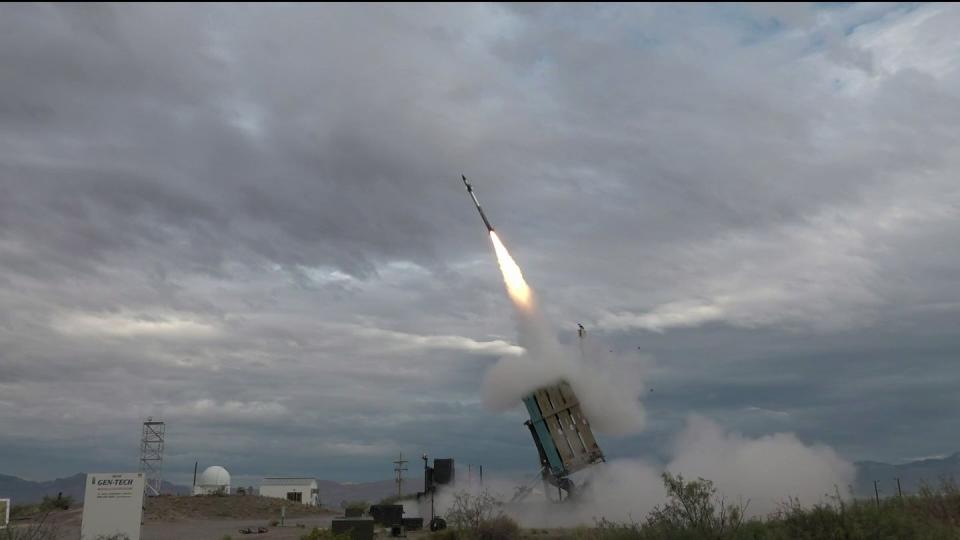RTX, Rafael eye Arkansas site to make air defense missiles
WASHINGTON — U.S. Marine Corps officials have met with defense industry representatives in Arkansas to discuss a potential facility to build air defense missiles pivotal to the service’s modernization plans.
The Corps’ Program Executive Office Land Systems has worked since 2018 to combine existing technology to create a short- to medium-range air defense system to defend Marines against cruise missiles and other airborne threats. This effort for a so-called Medium Range Intercept Capability incorporates two systems already in the service’s inventory: the Ground/Air Task Oriented Radar, and the Common Aviation Command and Control System.
It also relies on a piece of Israeli gear: the Tamir intercept missile built by Rafael Advanced Defense Systems that’s part of the Iron Dome homeland defense system.
Rafael is partnering with the American firm RTX (formerly Raytheon Technologies) to build these missiles in the U.S. under the collaborative name Raytheon Rafael Systems, or R2S. Company representatives met with program officials in Camden, Arkansas, on July 19 to discuss their concept for a production facility and to tour the potential site, the Marine Corps announced this week.
“This will be a great thing for the Medium Range Intercept Capability program and for the USMC, if this occurs,” Don Kelley, the program manager for ground-based air defense at PEO Land Systems, said in a service statement. The statement noted the location would not only provide a U.S. production line for the American version of the missile, dubbed SkyHunter, but could also serve as a second source of Tamir missiles for the Israel Missile Defense Organization.
Marines put the intercept capability through a series of successful live-fire tests in September. In December, the service decided to move forward and prepare a first platoon for a deployment in fiscal 2025. In a later decision, the service determined it would buy Medium Range Intercept Capability systems for up to three batteries from FY25 to FY27.
“We’re excited that MRIC testing has gone well and by all accounts the [U.S. Marine Corps] is moving forward with this important air defense program. It’s premature, at the moment, to confirm details related to the status or the location of our planned U.S. production facility. When established, it will be the first production facility in the U.S. to help support the [Defense Department] and allies across the globe with this highly-capable, medium-range air defense weapon system,” RTX told Defense News in a written statement.
The two businesses announced in 2020 they would establish an “all-up-round” Iron Dome production facility in the U.S. They had already partnered on the program, following a 2014 agreement for RTX to supply major components of the Tamir missile to support Rafael as the prime contractor.
“While a significant portion of Iron Dome is already built in the U.S., Rafael is cooperating and coordinating with our U.S. partner, Raytheon, regarding increasing U.S. production for our U.S. customers. This is part of our broader commitment to fully Americanize the system and meet U.S. requirements for technology transfer,” Rafael told Defense News in a statement.

The Corps is refining and beginning to execute operational concepts that rely on spreading out small groups of Marines across an operating area that’s within range of enemy weapons. The Medium Range Intercept Capability would be an “imperative” organic air defense capability for these Marines, according to the service, keeping them safe so they can focus on other missions like surveillance, setting up refueling and replenishment hubs, and firing on enemy targets.
The capability would detect, track, identify and defeat incoming cruise missiles and other manned and unmanned aerial threats.
The system was established as a middle-tier acquisition rapid prototyping effort and went from concept to live-fire testing in less than five years.
“Force Design 2030 [the service’s modernization effort] and updates emphasize experimentation and a strong air defense for the Marine Corps,” said Lt. Col. Matthew Beck, product manager for the envisioned capability. “Middle tier acquisition, with rapid prototyping, aligns with these goals. By integrating high technology readiness level components and seeking Marine feedback through small-scale deployments, we can refine and scale the Medium-Range Intercept Capability and get it to the fleet in a timely manner.”
“The real challenge lies in introducing this unprecedented system to the Marines who have no prior analogous equipment,” he added, but training and logistics teams are already working to build skill sets for those who would operate this system.
Even as the service works toward a first platoon deployment with a prototype in 2025, the program office is moving toward beginning formal procurement of the Medium-Range Intercept Capability system.
A quick-reaction assessment under the middle-tier acquisition rapid prototyping framework would take place in September 2024, the Corps reported, and the program could enter production in FY25.

